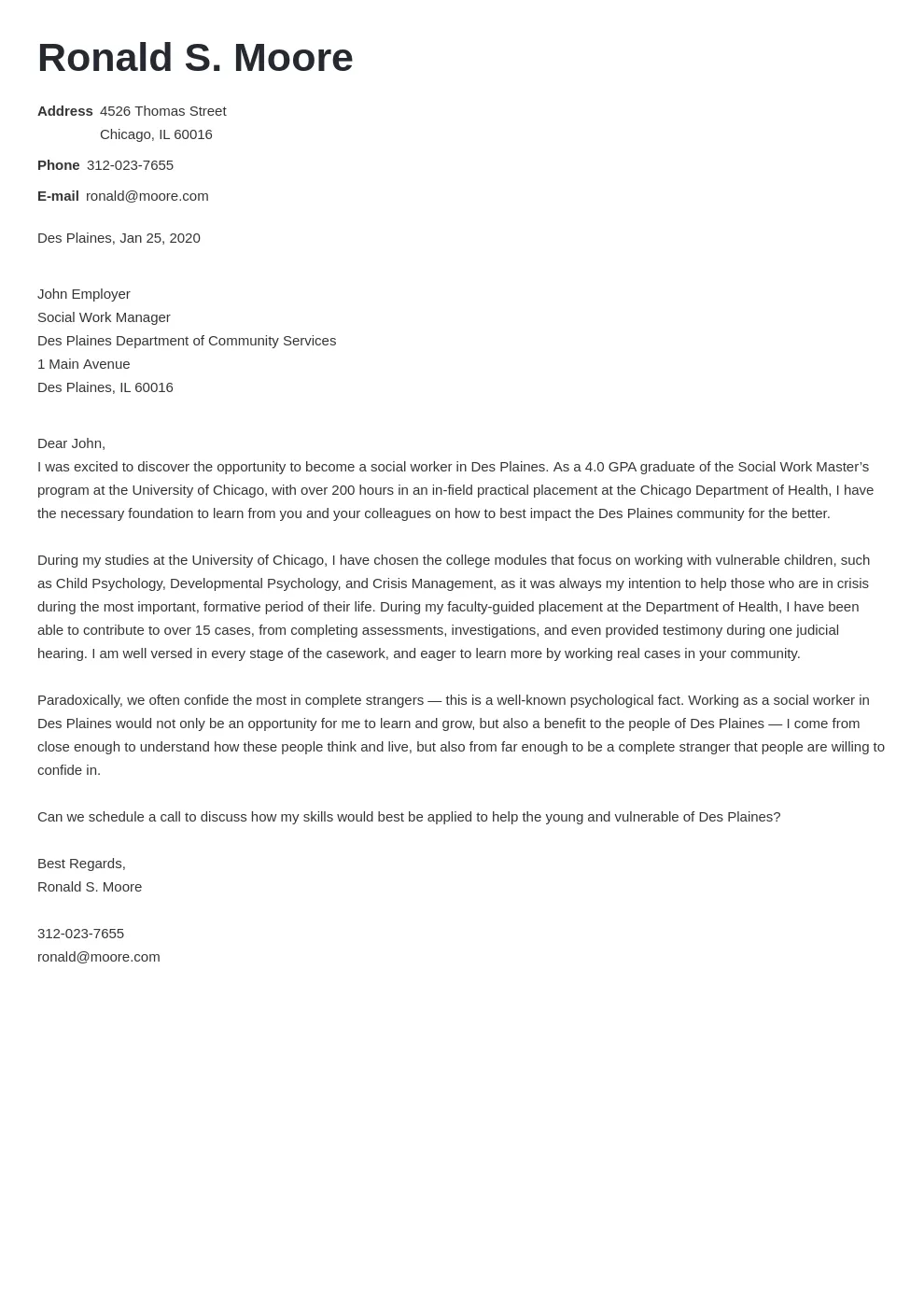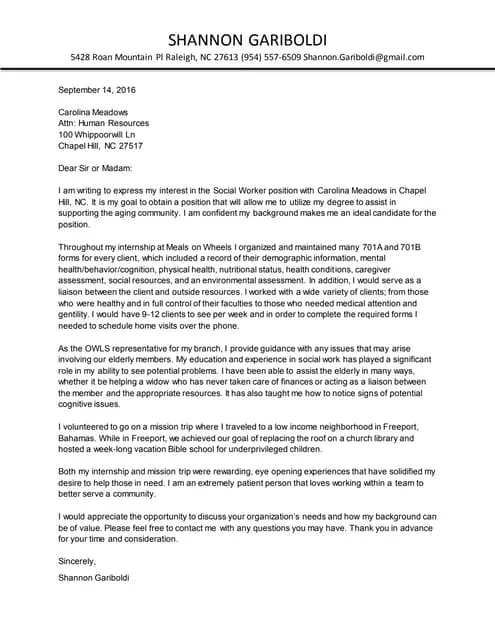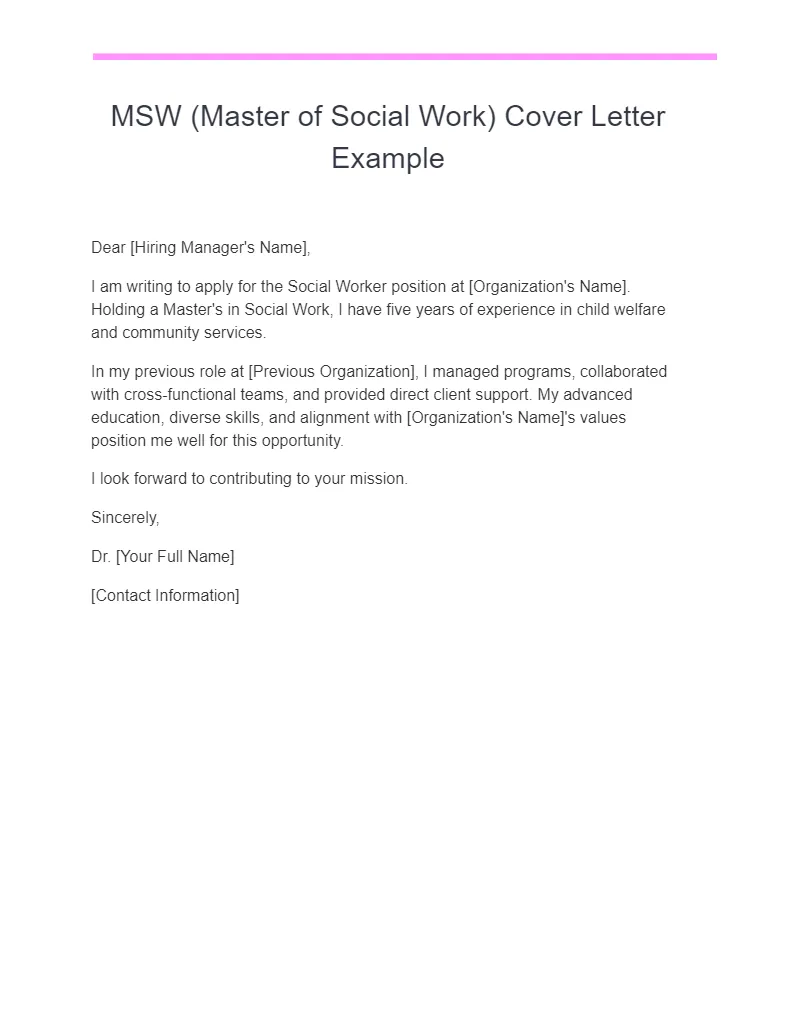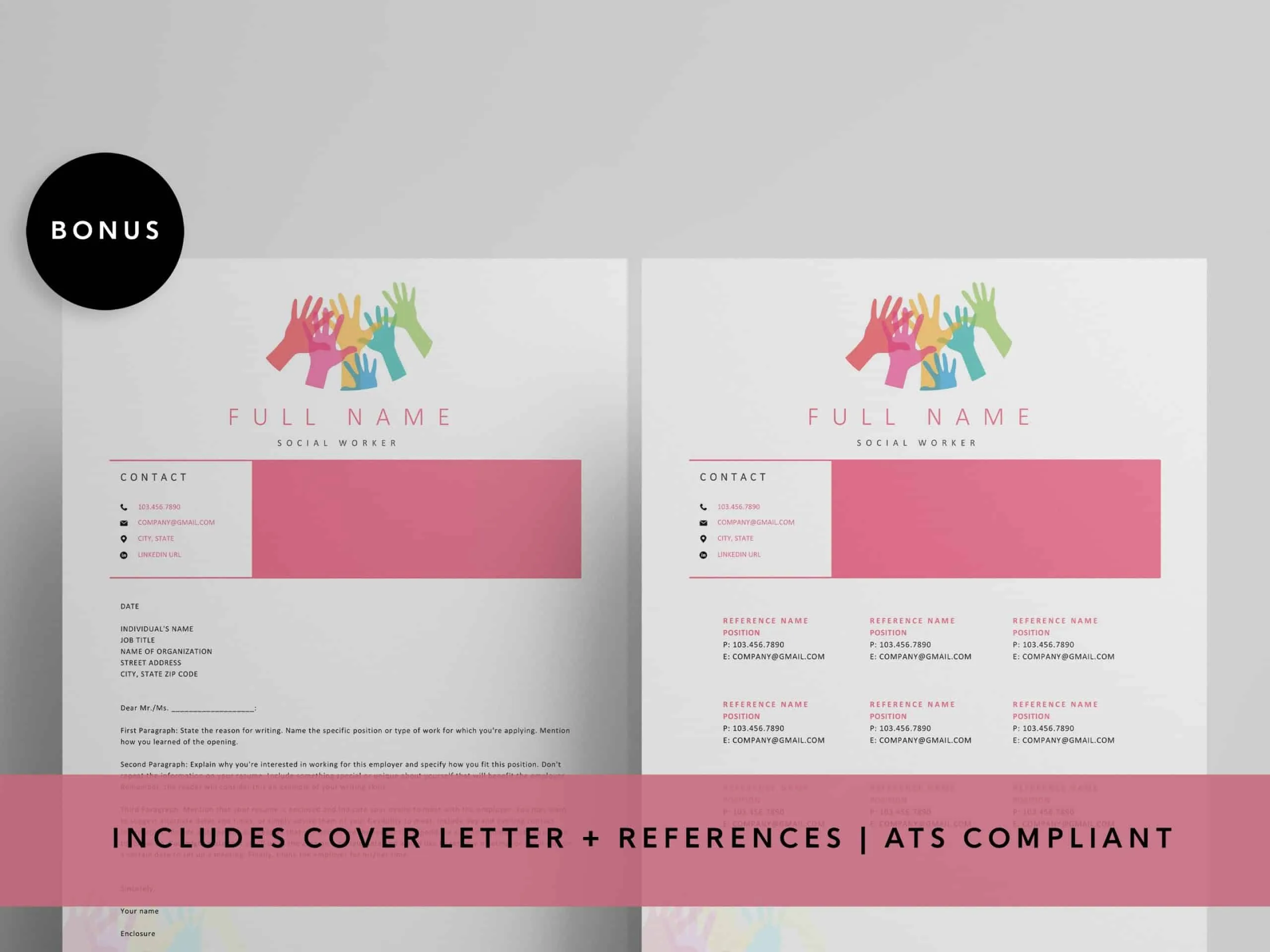Understanding the Social Work Cover Letter
A social work cover letter is more than just a formality; it’s your opportunity to make a strong first impression. It serves as your initial introduction to a potential employer, providing a chance to showcase your skills, experience, and passion for the field. This document is a vital part of your job application. It goes beyond the facts presented in your resume. It allows you to express your personality, connect with the hiring manager, and demonstrate why you are the perfect fit for the role. It should be compelling, providing insight into your motivations, understanding of the role, and alignment with the organization’s mission. A well-written cover letter dramatically increases your chances of securing an interview and landing your dream job. It can set you apart from other candidates.
Purpose of a Cover Letter for Social Work
The primary purpose of a cover letter in social work is to explain your interest in a specific role and demonstrate how your abilities align with the needs of the agency. It goes into further detail than your resume. It allows you to explain why you’re uniquely suited for the position. In the competitive field of social work, a well-crafted cover letter lets you showcase your understanding of the agency’s mission, the client population, and how you can contribute to positive outcomes. You can express your passion for the profession, your dedication, and your commitment to making a difference. It also provides a platform to display your writing skills, crucial for tasks like report writing and client communication.
Key Elements of a Social Work Cover Letter

A successful cover letter for a social worker includes several key components. Each part contributes to an effective and engaging narrative. It begins with a professional header, including your contact information, the date, and the recipient’s details. Your opening should immediately grab the reader’s attention, explaining the position you are applying for, and your enthusiasm. The body of the letter is where you detail your relevant skills, experiences, and tailor them to the job description. You should showcase your achievements, quantifying your accomplishments, and express your passion for social work. Your motivation for applying must be clearly stated, along with an understanding of the organization’s mission. The closing should reiterate your interest and availability, followed by a professional sign-off. Finally, thorough proofreading and editing are crucial to ensure a polished presentation.
Header Section of Your Cover Letter
The header is the first thing a hiring manager sees. It sets the tone. Start with your full name, address, phone number, and email address at the top left. Use a clear, readable font such as Arial or Times New Roman, with a font size of 11 or 12 points. Below, include the date, the hiring manager’s name and title (if known), and the organization’s address. Use a general title like “Hiring Committee” or “Hiring Manager” if you don’t know the hiring manager’s name. This part sets the tone and provides essential contact information. The correct formatting in your header conveys a positive first impression and demonstrates your professionalism.
Your Contact Information
Ensure your contact information is current and easy to access. Include your full name, address, phone number, and a professional email address. Avoid using unprofessional email addresses. Always double-check the phone number and email address for accuracy. The goal is to make it simple for the employer to reach you. Accurate contact information shows attention to detail, a critical quality in social work.
Date and Recipient Information

After your contact information, include the date. Then, state the hiring manager’s name, title, and the organization’s address. If possible, address the cover letter to a specific person. This shows you pay attention to details and take initiative by finding out who to address it to. If you can’t find the hiring manager’s name, address the letter to the Hiring Committee or Hiring Manager. The correct formatting of the date and recipient’s details enhances the professionalism of your cover letter and increases the likelihood of a positive impression.
The Salutation: Addressing the Hiring Manager
The salutation sets the tone and should be professional and respectful. If you know the hiring manager’s name, use “Dear Mr./Ms./Mx. [Last Name],” followed by a comma. If you are unsure of the hiring manager’s name, use a more general greeting such as “Dear Hiring Manager,” or “Dear [Department Name] Hiring Committee.” Avoid using generic greetings like “To Whom It May Concern.” The salutation should match the overall professional tone. A well-chosen greeting shows you researched the organization and the specific job, demonstrating your interest and initiative.
Crafting a Compelling Opening Paragraph
The opening paragraph should grab the reader’s attention and make a strong first impression. State the position you’re applying for and where you found the job posting. Express your enthusiasm for the opportunity and the organization right away. Keep it concise, focused on highlighting key aspects. It should immediately demonstrate your suitability. The opening should clearly indicate you understood the job requirements and possess relevant skills. The best opening paragraph is specific to the job you are applying for.
Highlighting Your Relevant Skills and Experience

The body of your cover letter details your skills and experience to prove your suitability for the role. Review the job description, noting key skills and qualifications the employer is seeking. Customize your cover letter to meet those needs. Use specific examples to show how you have demonstrated those skills in previous roles or experiences. Describe your experience, education, training, certifications, and any volunteer work. When describing your skills, use the STAR method (Situation, Task, Action, Result). This will provide context. Explain your responsibilities, describe actions you took, and highlight positive outcomes. Emphasize how your skills align with the organization’s needs and the job requirements.
Tailoring Your Skills to the Job Description
Customization is key when matching your skills to the job description. Each job requires different skills. Study the job description very carefully to understand the specific requirements. Analyze the desired skills and match them with your expertise. Use the exact keywords that appear in the job description. Provide concrete examples to show how you have used the skills. This proves that you not only have the skills but also know how to use them in a professional setting. Highlight how your unique skills can benefit the organization. Always prove you can add value to their team and the overall mission. Tailoring your skills to the job requirements makes it easy for the hiring manager to see the direct correlation between your qualifications and the job’s demands. It supports your argument for why you are the best fit.
Showcasing Your Achievements
Highlighting your achievements effectively demonstrates your value. Provide specific examples showing significant impact. Think about projects, cases, or initiatives where you made a difference. Quantify your achievements whenever possible. Providing quantifiable results proves your abilities and demonstrates the outcomes you’ve delivered in the past. The best achievements should be relevant to the job you are applying for. Your achievements should match the organization’s goals and the role’s requirements. By focusing on your accomplishments, you can show your capabilities and increase the chance of an interview.
Quantifying Your Accomplishments

Quantifying your achievements adds credibility and provides clear evidence of your impact. Instead of saying you “improved client outcomes,” say you “improved client outcomes by 20%.” Use numbers, percentages, and statistics to demonstrate results. Provide specific measurable data. This makes your achievements more persuasive, showing your effectiveness. Quantifiable data makes your cover letter stand out and make a strong impression.
Demonstrating Your Passion for Social Work
Passion and commitment drive the field of social work. In your cover letter, demonstrate your enthusiasm for the field. Express your dedication to helping others and your commitment to social justice. Share what motivates you. Include personal experiences that shaped your values. Explain how you understand the challenges faced by clients. Show that you’re committed to addressing these issues. The hiring manager will recognize your passion, and this can help you stand out from the other candidates.
Explaining Your Motivation for the Role
Clearly explain why you want this specific role and what attracts you to the organization. Research the organization’s mission, values, and the populations they serve. Incorporate these elements into your letter. Explain how your skills and experience align with the job requirements. Connect your career goals to the organization’s mission. This shows your commitment to the organization’s success. Explain how you understand the role’s challenges and how you will be successful. Your explanation should show the hiring manager that you want the right job at the right organization.
Expressing Your Understanding of the Organization’s Mission

Demonstrate your understanding of the organization’s mission and how your goals align. Research the organization’s mission statement, values, and current projects. Highlight how your skills can contribute to their goals. Mention the organization’s commitment to specific populations or issues. Explain how you can help advance the organization’s objectives. The hiring manager looks for someone who shares the organization’s values and is excited to contribute to its mission. Expressing your support will show you took the time to understand the organization and will make a meaningful impact.
Closing Your Cover Letter Effectively
The closing paragraph should reiterate your interest, thank the hiring manager, and express your availability for an interview. Briefly summarize your key qualifications. Include a call to action, such as “I look forward to hearing from you soon.” Proofread and edit your closing to ensure the tone remains positive and professional. The closing paragraph is your last chance to make a good impression. It reinforces your suitability for the role and interest in the organization.
Reiterating Your Interest and Availability
Reiterate your strong interest. Re-emphasize your key skills, highlighting your contribution to the organization. Express your availability for an interview and provide your contact information. Thank the hiring manager for their time and consideration. Show that you’re excited and ready to move forward. This helps your cover letter leave a positive and lasting final impression.
Using a Professional Closing

Choose a professional closing that reflects your cover letter’s tone and shows respect. Use closings like “Sincerely,” “Best regards,” or “Respectfully.” Avoid casual closings such as “Thanks.” End with your typed name and signature. The professional closing should be polite and respectful. It reinforces your image.
Proofreading and Editing Your Cover Letter
Before submitting, carefully proofread and edit your cover letter. Errors can make you appear careless. Check for grammar, spelling, and punctuation mistakes. Make sure your sentences are clear. Read your letter aloud to catch any awkward phrasing. Ask a friend to review your letter and give you feedback. Pay close attention to formatting, font, margins, and spacing. Proofreading ensures your cover letter is polished, professional, and error-free.
Common Mistakes to Avoid
Avoid generic templates. Don’t just repeat your resume. Instead, elaborate and add context. Avoid jargon and slang. Maintain a professional and enthusiastic tone. Don’t include irrelevant information. Avoid errors and mistakes. Always customize your letter. By avoiding these mistakes, you can improve your cover letter.
Examples of Strong Social Work Cover Letters
To understand how to create an effective cover letter, review examples of successful social work cover letters. These examples show you how to structure your letter, highlight your qualifications, and express your passion. Analyze how candidates have tailored their letters to specific job descriptions. Take note of the language and how they showcase their skills. Customize the template to match your skills. By studying these examples, you can write a cover letter that stands out. Remember to always tailor your cover letter to the job requirements.
